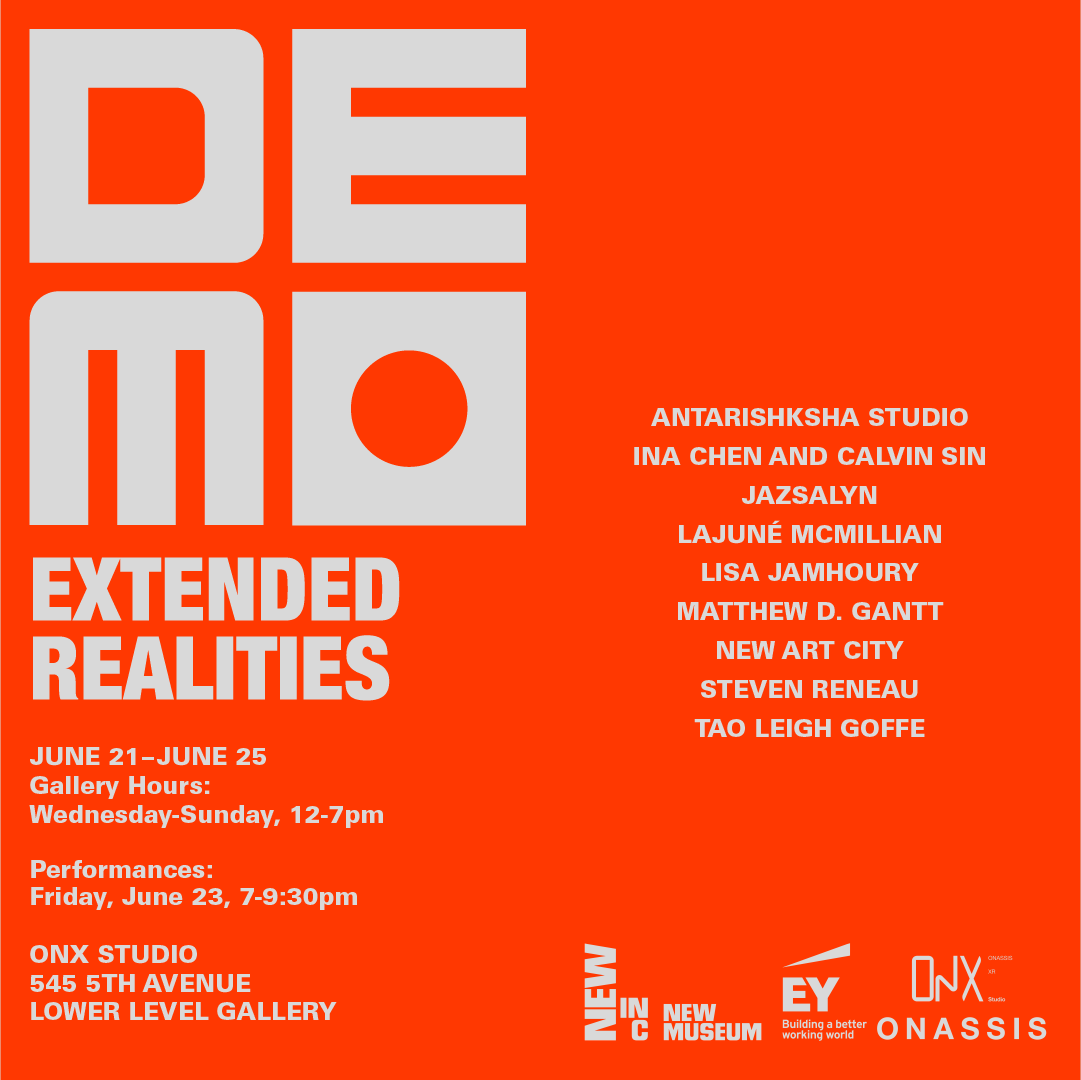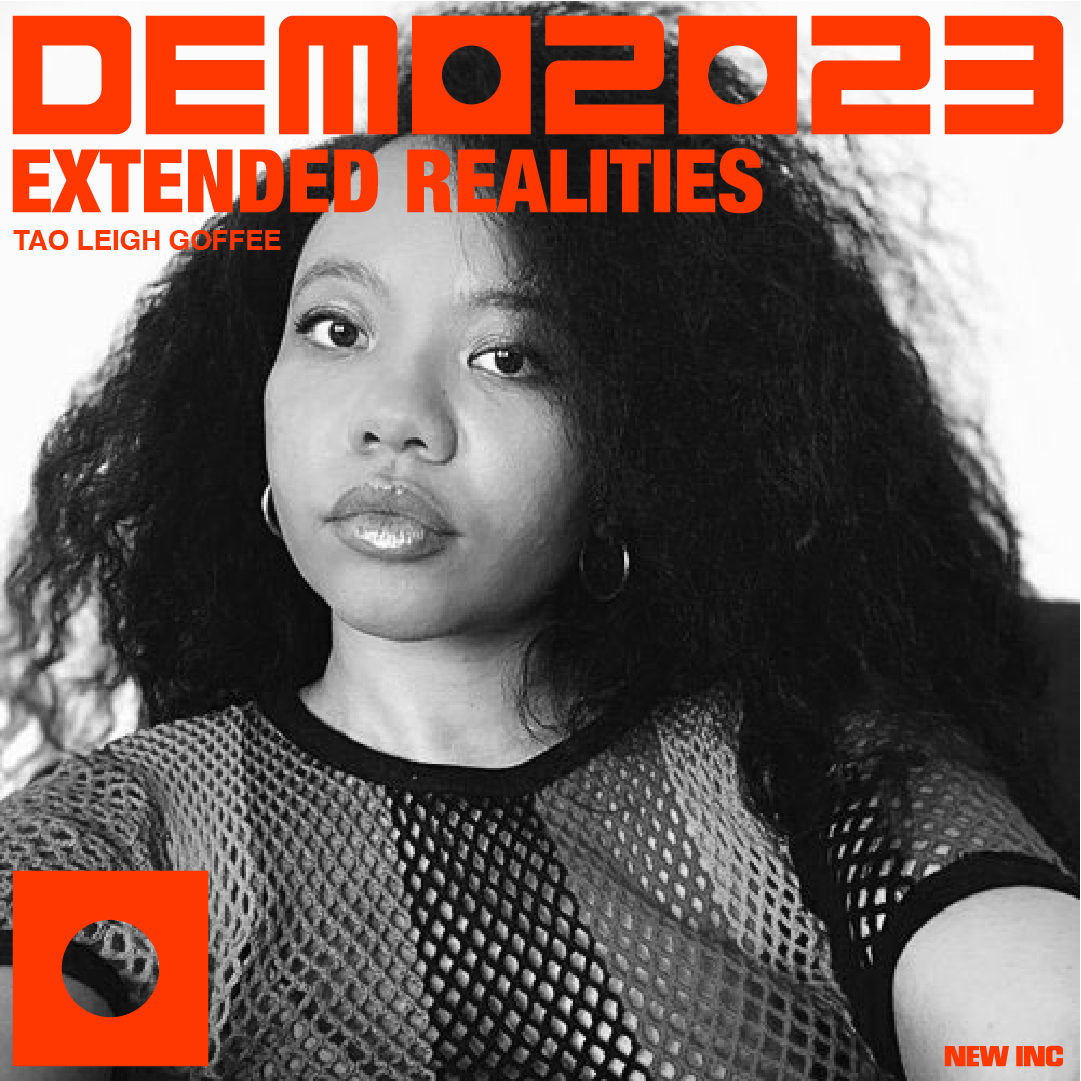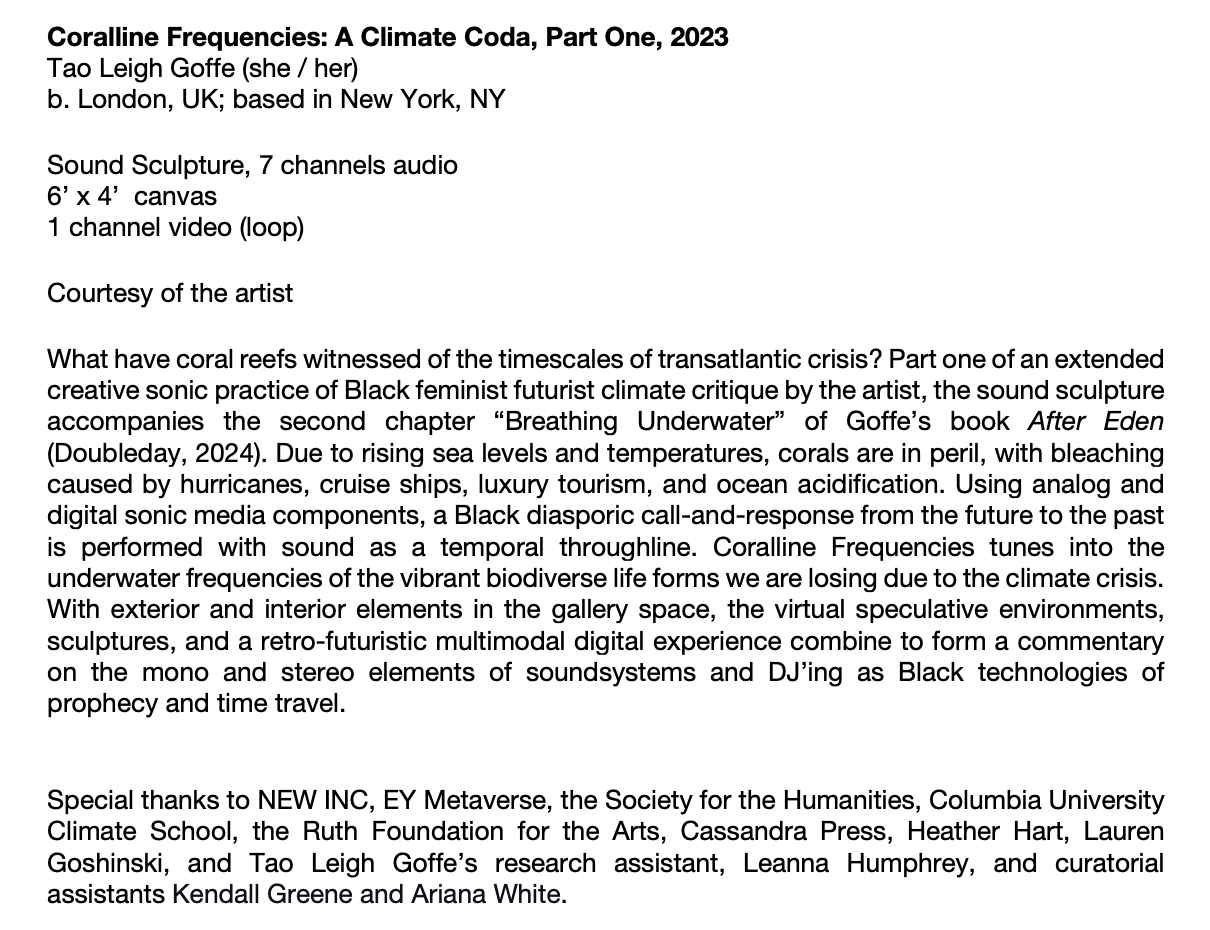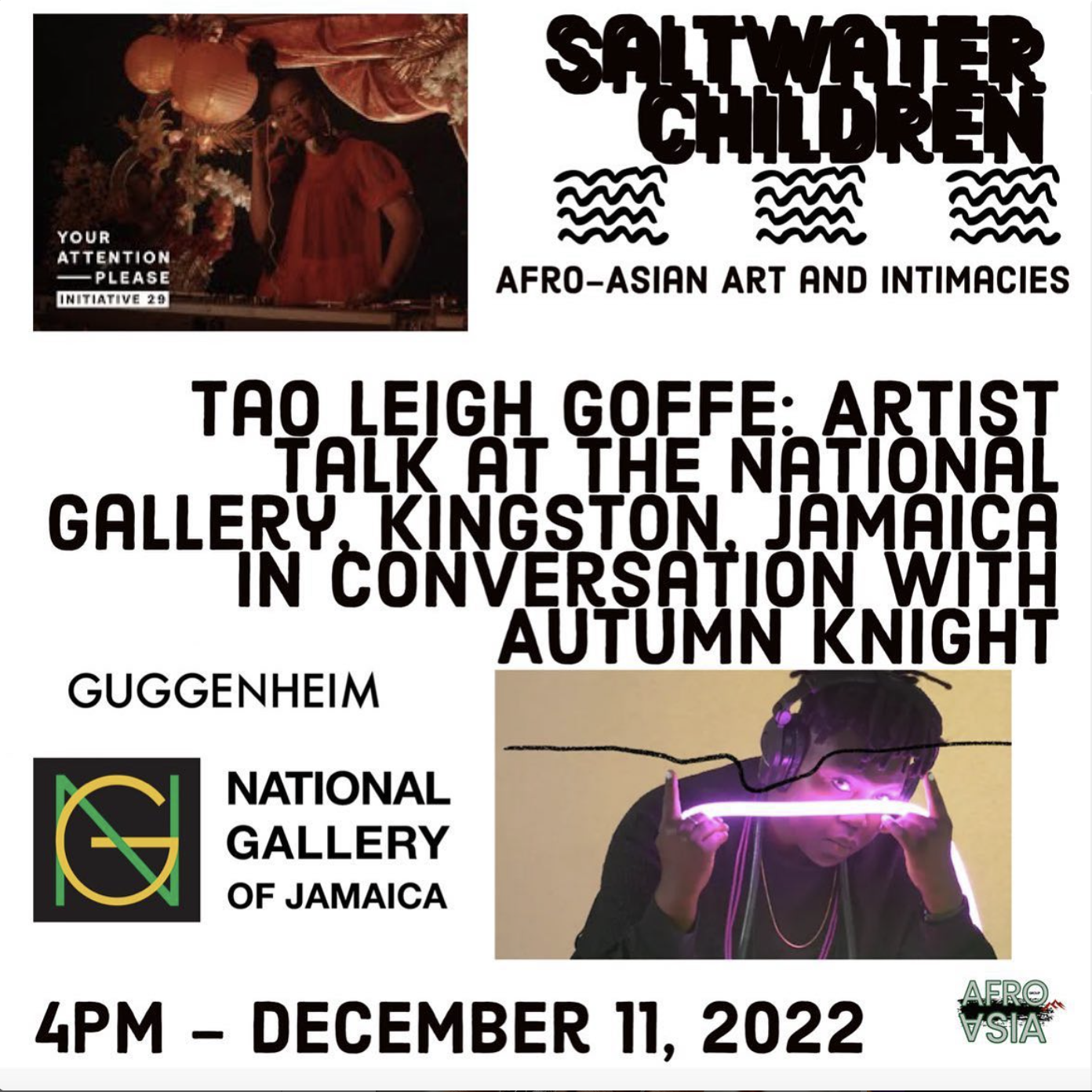art
-
Tao Leigh Goffe is an interdisciplinary sound artist and art writer. Her primary mediums are sound, sculpture, and media technologies (both analog and digital). She was invited to give an artist talk on her practice by the Guggenheim Museum in New York and in Kingston, Jamaica at the National Gallery in 2022. Facilitated by artist Autumn Knight, in the Jamaican event Goffe presented video work on Black Pacific and Chinese Atlantic labor histories in a piece called SALTWATER CHILDREN.
Her artwork is currently on exhibition at the Institute of Jamaica (IOJ - the nation’s natural history museum) in Kingston as part of a group show that re-imagines Queen Nanny of the Maroons (2022-2023). Goffe produces videos, sound sculptures, and installations that foreground digital tools as a way of critiquing overlapping European colonialisms and creating sonic kinship through technologies. She was part of a group exhibition EXTENDED REALITIES presented by the New Museum as part of their art and technology incubator (June 2023). Goffe has been commissioned to produce artwork that address climate crisis and sonic speculative environments as an artist-in-residence at Columbia University (2022-2024). The sculpture CORALLINE FREQUENCIES is part of an ongoing series.
Having taught a studio course at Cornell University’s Architecture School called “Black and Indigenous Metropolitan Ecologies” (2021) as tenure-track professor (since 2019), her work is especially engaged spatially on questions of theory, design, burial, race, and colonialism. Her works examine how metadata and other taxonomies function as colonial sorting tools attempting to segregate life.
Goffe was born in London, United Kingdom, and lives and works in Manhattan. She received her PhD from Yale University and her bachelor’s degree from Princeton University. Goffe’s curatorial contributions have been made to exhibitions in venues including CCADI, Harlem; Sound and Vision, Hilversum, Netherlands; and Pen and Brush, New York.
Goffe is the recipient of a $100,000 grant by the National Endowment for the Humanities in collaboration with the British government on endangered imperial archives. She was invited to develop a community-engaged initiative by the Mellon Foundation and received an award of $2 Million over three years for transformative Black feminist digital and analog praxis.
Goffe has given invited lectures internationally on sound, technology, sexuality, and race at University of the West Indies, Harvard University, Tisch, Leiden University, University of Chicago, and the California College of the Arts. She is often invited to participate in artist talks and has enjoyed being a discussant with fellow artists and art critics at Galerie Lelong and Asia Art Archive. She also serves as a peer reviewer for art museum catalogues.
-
Tao Leigh Goffe is part of the Extended Realities (XR) track and a Year 9 member (2022-2024) of NEW INC. Founded by the New Museum, it is the first museum-led incubator for art and technology. She is participating in or has collaborated as part of art residencies at the Columbia University Climate School (2022-2024), University of Connecticut (2021), University of California, San Diego (2021-2022). Her art cv is available by request.
-
Tao’s art writing and criticism has appeared in peer-reviewed and popular publications: Artsy, Asia Art Archive, ASAP/J, Boston Review, Asian Diasporic Visual Culture in the Americas, Small Axe, Refract: A Visual Studies Journal, and Shift Space (Knight Foundation). She has been interviewed by the New York Times, the Washington Post, Men’s Health Magazine, and Vice Munchies about her work.
coralline frequencies, part one, a climate coda (2023-Ongoing)
Photo credit: Tsubasa Berg
DEMO2023 is a new festival created by NEW INC and presented by the New Museum. Open to the public for the first time, DEMO2023 will take place over three days and feature talks, showcases, performances, with additional events and programs at five partner locations across lower Manhattan.
Running from June 21 to June 23, 2023, DEMO2023 will feature speakers and performers including Anicka Yi, Dong-Ping Wong, Eartheater, Hassan Rahim, WangShui, Embaci with Studio Junbi, Onyx Collective, M Lamar, Eileen Isagon Skyers, and Yemi Amu, and will spotlight innovative projects from twenty-five current NEW INC members, whose interdisciplinary work spans art, design, technology, and science.
Visit demo2023.org to check out the festival schedule.
maroon / mawon / marron (2022-Ongoing)
Currently on display in Kingston, Jamaica at the Institute of Jamaica, the island’s Natural History Museum.
An archive of the ongoing series maroon / mawon / marron by Tao Leigh Goffe, what follows is an emphasis on process, experimentation, and iteration. A single question, “How does marronage translate across different national contexts?” is answered in analog and digital interpretations and artistic reckonings of fugitivity and insurgency. Black resistance transfigures across the Western hemisphere. A constantly shifting and mutating practice, translating the ineffable nature of marronage is all but impossible. This series maroon / mawon / marron challenges the binaries of gender essentialism, xenophobic nationalism, and language as barriers that attempt to contain and curtail radical acts of liberation and survival. Below listen to the sound installation on exhibition at the Institute of Jamaica as part of the group show Re-imagining Nanny of the Maroons (Nov 27, 2022-March 21, 2023) in Kingston, Jamaica.
Kill them with the “No!” (2022)
Sound Installation (3 minutes, 35 seconds)
Taking its name from the chorus of a well-known dancehall track, Kill them with the “No!” is a Black futurist mountain song. It is a reverberating soundtrack of call-and-response from the future to the past for Queen Nanny. This sound installation forms the digital audio component of the artwork Queen Nannies on display at the Institute of Jamaica as part of the Re-Imagining Nanny of the Maroons exhibition, activated by a QR code wall text at the gallery.
The abeng, the Maroon and Akan musical instrument formed from a cow horn, is in dialogue with dancehall in this sonic interpretation of futurist mountain songs of intergenerational communication. Imagining the echoes held by the Blue and John Crow Mountains, Grandie Nanny’s soundtrack of defiance is a chorus of ‘nos’ through Black survival. Jamaican parrots, crickets, and tree frogs form the nighttime symphony that comes alive when the sun sets. The heartbeat is the drumbeat of Black resistance, a pulse that forms the beats per minute (BPM) of the African diaspora’s tempo.
Queen Nannies (2022)
Canvas, Gold Thread, Golden Frame
30 x 40 inches
Among the inheritors of Queen Nanny’s defiance, many Black people refuse the terms of surrender because the battle against European colonial conquest is not complete. Beyond Nanny Town in Jamaica, Grandie Nanny’s lore spawned an army across the generations and across geographies of women and femmes with their heads held high in defiance. The Black gaze challenges the viewer by saying, “No!” There is a Jamaican inflection of a type of “No!” that cuts differently than how “no” is said in other languages. Queen Nannies is a statement about how the legacy of the revered Akan warrior queen multiplies. Her “No!” echoes outward across the archipelago.
Jamaican women know how to say, “No.” Part of saying “No” is the art of survival, which Queen Nanny practiced for her people with West African horticultural and religious ritual practices including Obeah that continue across space and time. Petals of the pumpkin blossom in Queen Nannies form the bell of her dress. The figure with its back turned to us, walks into the far future gripping a machete. The war between West Africa and Western Europe is not over and there are many generals who continue to follow Nanny’s battle plan of resistance. Through gran and petit marronage, people of the African diaspora across the Americas from the Blue and John Crow Mountains to the Great Dismal Swamp to the interior of Suriname’s rainforest continue to fight in major and minor acts of refusing European colonialism.
Though Grandie Nanny died in 1733, in this painting she is invoked as continuing to recruit battalions. Those who in their everyday lives are underestimated stand tall situated here as healers, herbalists, gardeners, domestics, military strategists, and commanders. They are the global workforce of nurses, nursing home workers, and nannies who have migrated from the Caribbean for over a century. An exploited labour force paid meagre wages, their job is to care for others. Queen Nannies depicts the collective power of these workers and their knowledge in cultivation, raising children, and caring for the dying. Pictured are photographs of migrant domestic women workers from the French Caribbean in the 1910s who form a collective. Black women’s labor circulates across the globe while their mobility is limited.
The twin mountain structure connects the Black geologies and bedrock of the Caribbean archipelago and the history of women maroons in Jamaica and Dominica. The tartan patterns associated with both sovereign nation's form the backdrop for the women’s figures layered on a mountain that forms an island. Mountainous terrains and the hinterlands were a sacred and lush spaces of refuge and ceremony for Maroons in Jamaica and Dominica.
I founded the creative technology studio called Dark Laboratory in 2020 with the ethos of exploring what has been stolen from Black and Indigenous people and honoring the many creative ways we continue to survive. European colonialism pitted Amerindian and Black lives against one another in the crossroads of the Western hemisphere. Camouflaged are deep histories of Maroon and Taíno coalition that we taste in our cuisine. The darkened backdrop represents the dark of night, illuminated by the moon. A colonial era text from a slave registry is faintly imprinted as a backdrop evoking the night sky. Parrots, threatened endemic species in Jamaica and Dominica, stand guard to the Queen Nannies for what is to come regarding the future of Caribbean sovereignty.
Institute of Jamaica, November 27, 2022-Ongoing
Re-imagining Queen Nanny of the Maroons, Her Sword, a Seed
Artist Talk by Tao Leigh Goffe by the Guggenheim Museum at the National Gallery of Jamaica, December 11, 2022.
Discussant: Autumn Knight (artist).
"Indebted Literacies," Maternal Imprinting, (2021). From a series that explores the imprint of racial indenture, colonial legacies of debt bondage, and racialization of African and Asian diaspora subjects.
"Three," Metropolitan Ecologies, (2021) Part of a series on the urban landscape and architecture of women who have historically been paid to care in New York City.
"What Water Logs" Talk is Cheap, (2022). From an ongoing series on Afro-Asian 'picture brides' that explores what silence communicates over the generations through food, passport photos, and materiality.
" soucouyant," Caribbean Queens (2021). From a series on myth-making, nightmares, pageantry, and sexuality in the Antilles.
A video still from the sound sculpture "Dirge" produced collaboratively as a monument to Black and Indigenous hemispheric burial (2021). It situates the wall of Wall Street as an architecture of racial capitalism. Four bricks in the wall represent soundscapes of Manhattan, Ithaca, the Caribbean, and the future to tell a history about stolen land and stolen life.
From the "Talk is Cheap" video series (2022). From an ongoing series on Afro-Asian 'picture brides' that explores what silence communicates over the generations through food, passport photos, and materiality.




















